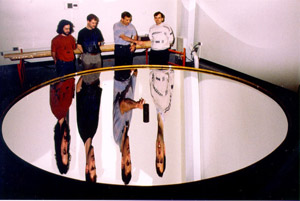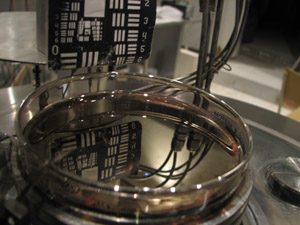A liquid reflector for a vast Newtonian telescope to be based on the surface of the Moon is being developed by scientists in Canada, UK, and US. The new type of telescope could provide the clearest views yet of ancient parts of the Universe.
Earth-bound liquid reflectors are more than a theoretical science fiction; they exploit the ability of mercury to form a thin layer that can be spun in a parabolic bowl to form a perfectly smooth reflector. Spin the bowl and a uniform layer in the shape of the parabolic bowl forms that can focus light from space, just as a satellite receiver focus the broadcast signal to a point. Telescopes with parabolic liquid mirrors are much cheaper and easier to make and maintain than conventional telescopes with glass mirrors. They require no cleaning or polishing and need only be a few hundred atoms thick to form a highly reflective surface.

A liquid mercury mirror (Credit: Guy Plante, Laval)
However, shipping a mercury cache to the Moon payload would not only be unviable but also pointless. In the low vacuum conditions of the lunar surface the mercury would simply boil.
Chemists at Queen’s University Belfast, however, realised that their non-volatile and lightweight ionic liquids could make the perfect substitute for mercury and form the requisite parabolic layer, which will have to be the size of a football field to be useful. A coating of metal particles on the surface of the ionic liquid would then be highly reflective in the infrared region of the electromagnetic spectrum and so pick up the enormously red-shifted light from the most distant stars and galaxies. Another advantage to a lunar station is that infrared light cannot be detected by telescopes on Earth because of atmospheric interference and light pollution.

Ionic liquid mirror with a silver coating (Credit: Omar Seddiki, Laval)
Ionic liquids are liquid salts consisting of bulky positively charged and negatively charged ions; not only will they not boil on the Moon, they will not freeze either. The discovery that an ionic liquid can be coated with a very thin metal layer is a major breakthrough, said chemistry professor, Kenneth Seddon, Director of Queen’s University Ionic Liquids Laboratories (QUILL).
QUILL scientists working with colleagues at Laval University, Quebec, the University of British Columbia, and project leader Roger Angel at the Steward Observatory, University of Arizona, reported that a commercially available ionic liquid can be given a silver coating that remains stable for several months, even in a vacuum at minus 98 Celsius. This temperature is marginally balmier than the surface of the Moon, so the team is now searching for an alternative but related ionic liquid with an even lower freezing point.
According to Seddon, there are a phenomenal number of ionic liquids to choose from, more than 1500 have been reported so far in the scientific literature, with about 500 of those available commercially. However, there are theoretically at least a million simple ionic liquids possible, the simple addition of another atom to the positive or the negative ion or swapping one atom for another produces an entirely new ionic liquid each time that may or may not have a lower freezing point.
We now plan to design and prepare ionic liquids with melting points of around -100 Celsius that can be coated with a reflective metal for the lunar telescope, adds QUILL’s Assistant Director Maggel Deetlefs. Angel suggests that the Lunar Liquid Mirror Telescope project, which is funded by a NASA Institute for Advanced Concepts grant, will probably not become feasible until at least 2020.
Further reading
Nature, 2007, 447, 979-981;
http://dx.doi.org/10.1038/nature05909
Queen’s University Ionic Liquid Laboratories
http://quill.qub.ac.uk/
J. Roger P. Angel’s homepage
http://www.optics.arizona.edu/Faculty/Resumes/Angel.htm
Suggested searches
telescopes
Moon